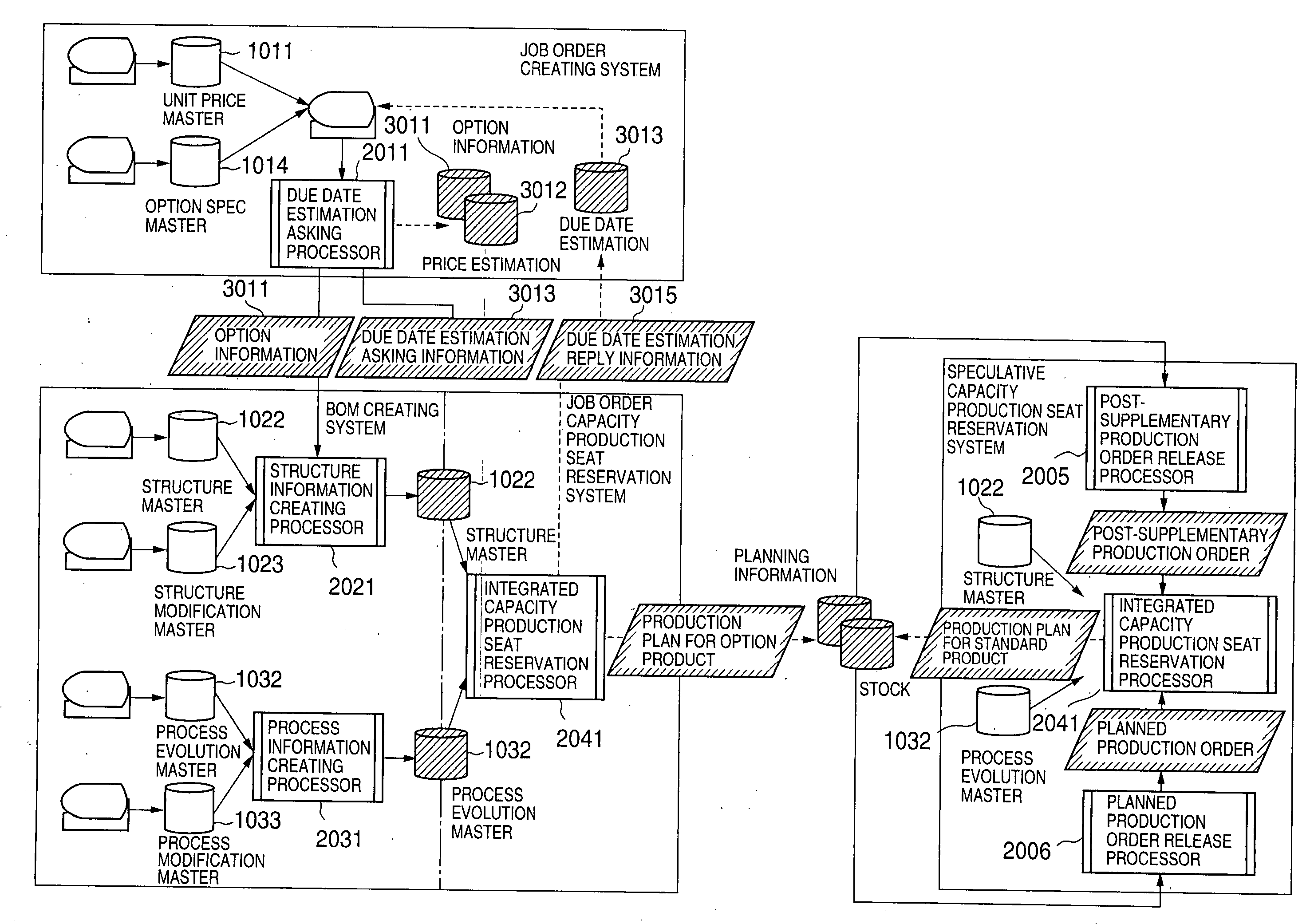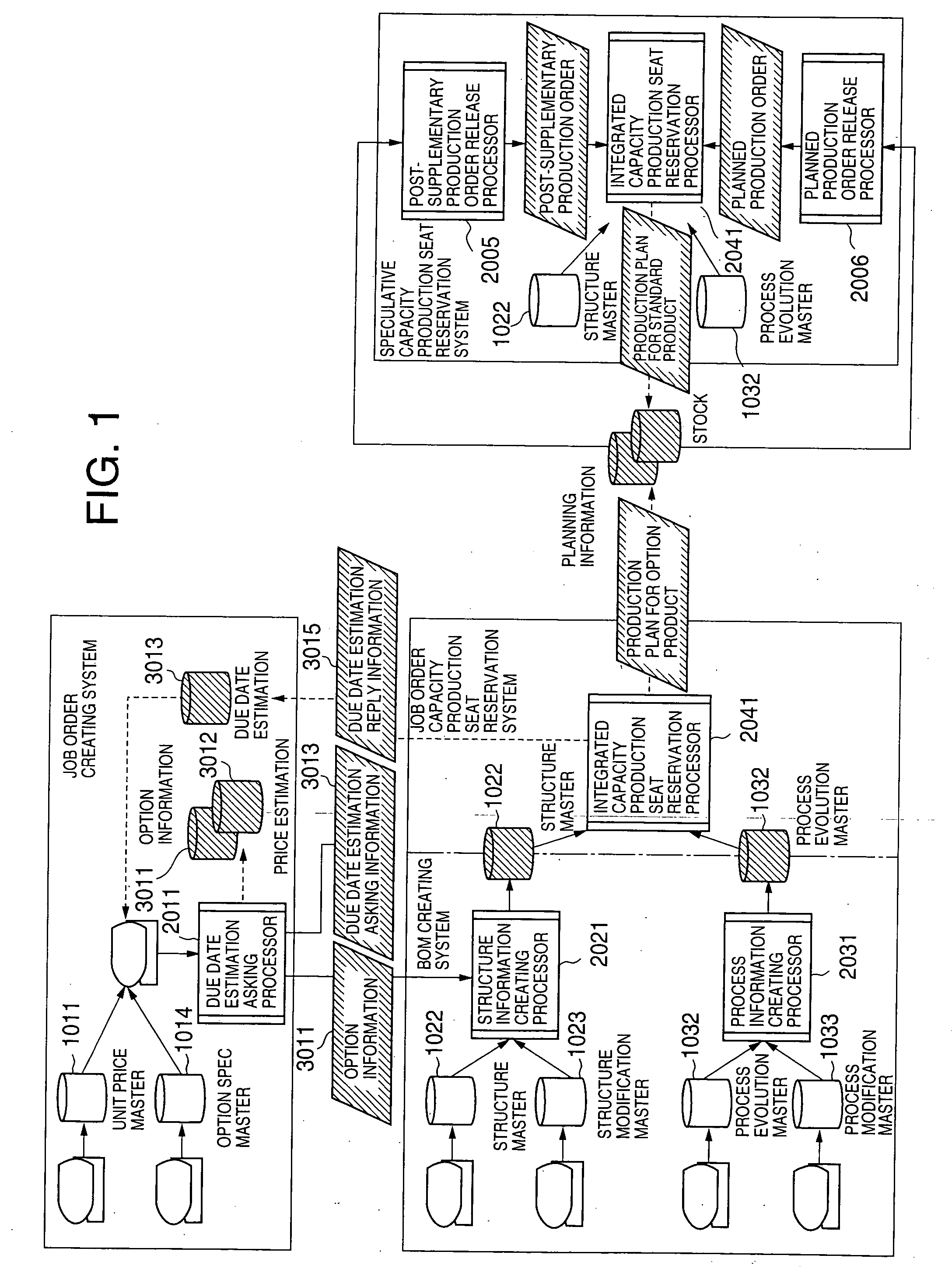In-stock items mismatching consumers' demand, for example, consumers' taste inevitably lose commercial values and become non-performing assets for producers.
On the other side of the
coin, the parts structure as well as the production process must be created in accordance with the particular order before actual production is started and the production efficiency is necessarily restricted.
In practice, the object to be manufactured by this system is limited to a small quantity of option specification products.
Consequently, it has been difficult for the make-to-order production system to improve the sales stability and the profit enhancement.
As a result, it has been apprehended that the stock of intermediate products and parts might become excessive as a demand trend fluctuates.
However, the post-supplementary production is normally destined to manufacture products each being of a small large quantity and different kinds and this nature of the post-supplementary production may cause the number of schedule changes to increase and cause the production efficiency to be deteriorated.
With a consequence, the order acceptance efficiency is relatively high but any significant improvement of production efficiency can not be expected.
In consequence, there is an
anxiety that a large quantity of parts might become excessive stock as the demand trends changes and the product specification correspondingly changes.
However, if the demand of the option specification product surpasses the forecast as the demands trend changes, the demand for the standard specification product will correspondingly decrease and an excessive stock will occur for the standard specification product.
This is for the reason that modification of the production planning for the standard specification product which has been once created would seriously affect the material planning and the resources planning which have already been determined and make it impossible to assure practicability of this production planning.
Inevitably, the due date for the option specification product would be delayed and opportunity for order acceptance would be lost.
In this case, the
delay of the due date for the option specification product can be avoided but the manufacturing resources such as production lines and man power would be required for these separate production lines and it would be difficult to manufacture the products at acceptably low cost.
In other words, immediate modification of the production planning is difficult.
In a consequence, there is a high possibility that an excessive stock for the standard specification product might occur.
MPR is the planning not taking a limit of manufacturing capacity into account and it is not always possible to assure a practicability of the production planning even if the material procurement planning has been precisely created.
While this system is the system adapted to modify the
list of parts and thereby to modify the structure of the product, it is impossible for this system to create the production plan taking account of a
load capacity of the manufacturing resources since this system does not take a limit of manufacturing capacity into account.
As a result of allocation, it is sometimes found that the load exceeds the capacity of the
manufacturing line and the process is not completed within the allocated time.
However, in order to determine a
manufacturing planning, a person working as a controller must adjust a resources planning and it has been impossible for the conventional MRPII to calculate the
manufacturing planning automatically taking account of constraints such as competition of respective processes in the
plant.
With a consequence, when the production planning of the product is created using the effective stock of the parts common to two different specifications, these common parts have often been excessively stocked in order to achieve a due date as early as possible.
Excessive stock inevitably not only increases a product cost but also makes it difficult to modify the production planning in response to the customers' demand and may sometimes lose the opportunity of order acceptance.
In addition, the excessive stock may lead to a large amount of dead stock and immobilization of a circulating fund of the producer.
However, it has been difficult for the conventional production
management system to create the production planning based on the specification, the due date and the quantity specified by the customer while excessive materials and stock is suppressed, a practicability of the production planning is assured and desired production efficiency is maintained.
As a result, it has been difficult to calculate the due date immediately upon acceptance of the order and to positively promise the due date.
The cost to achieve this has inevitably reflected on the
product price and often decreased the opportunities of order acceptance.
If such excessive stock of the materials as well as the resources has been eliminated in order to reduce the cost, it has become impossible to assure the practicability.
Consequently, it has been impossible to positively promise the due date once presented to the customer and eventually the opportunities of order acceptance have decreased.
For the conventional make-to-stock / make-to-order compromise production
management system, the substantial measure is limited to the commonage of the material planning between the products having different specifications.
Consequently, it has been impossible to continue the production planning for one and same product and modification of the process scheduling has necessarily become so frequent to deteriorate the production efficiency.
Due to such procedure, non-ordered post-supplementary production and the planned production both occupying the manufacturing resources have often prevailed over a job order production and delayed the due date thereof, leading to decrease the opportunities of order acceptance.
 Login to View More
Login to View More  Login to View More
Login to View More 


